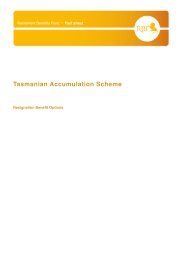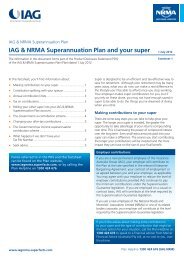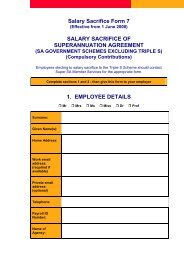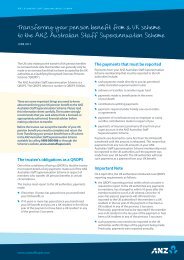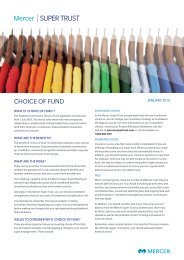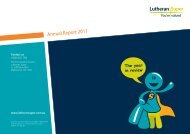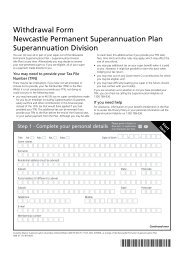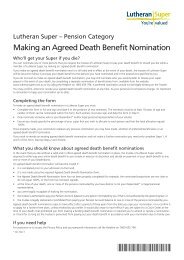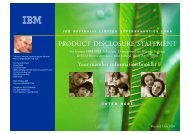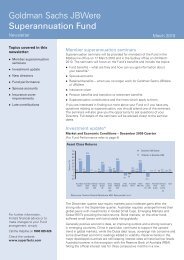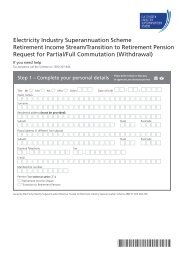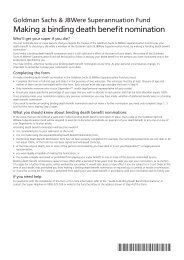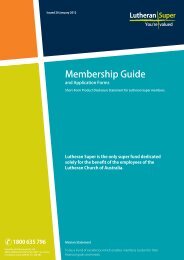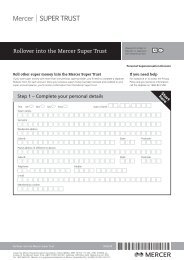Welcome to RBF Information in this brochure is ... - SuperFacts.com
Welcome to RBF Information in this brochure is ... - SuperFacts.com
Welcome to RBF Information in this brochure is ... - SuperFacts.com
You also want an ePaper? Increase the reach of your titles
YUMPU automatically turns print PDFs into web optimized ePapers that Google loves.
<strong>Wel<strong>com</strong>e</strong> <strong>to</strong> <strong>RBF</strong><br />
Retirement Benefits Fund<br />
<strong>Wel<strong>com</strong>e</strong> <strong>to</strong> <strong>RBF</strong><br />
<strong>Information</strong> <strong>in</strong> <strong>th<strong>is</strong></strong> <strong>brochure</strong> <strong>is</strong> current as at 1 July 2011<br />
Retirement Benefits Fund
<strong>Wel<strong>com</strong>e</strong> <strong>to</strong> <strong>RBF</strong><br />
Table of<br />
contents<br />
1 <strong>RBF</strong>’s <strong>com</strong>mitment<br />
Tasmanian Accumulation<br />
Scheme<br />
2 Contributions<br />
Chr<strong>is</strong> (Firefighter), <strong>RBF</strong> member<br />
Super Co-contribution<br />
How much <strong>is</strong> enough?<br />
3 Investment Account<br />
4 Can I choose how<br />
my superannuation<br />
<strong>is</strong> <strong>in</strong>vested?<br />
What charges will I pay?<br />
5 What retirement benefits<br />
will I receive?<br />
6 The <strong>RBF</strong> Board<br />
Right <strong>to</strong> appeal<br />
<strong>RBF</strong> Board dec<strong>is</strong>ions<br />
7 Death and<br />
Incapacity Cover<br />
10 Feedback<br />
Further <strong>in</strong>formation<br />
On the cover<br />
Nicole (Adm<strong>in</strong> Ass<strong>is</strong>tant),<br />
<strong>RBF</strong> member<br />
Important <strong>in</strong>formation<br />
Th<strong>is</strong> document <strong>is</strong> <strong>is</strong>sued by the<br />
Retirement Benefits Fund Board<br />
(ABN 97 224 593 931). The Retirement<br />
Benefits Fund Board <strong>is</strong> trustee of<br />
the Retirement Benefits Fund (ABN<br />
51 737 334 954). The <strong>in</strong>formation <strong>in</strong><br />
<strong>th<strong>is</strong></strong> document <strong>is</strong> for members of the<br />
Tasmanian Accumulation Scheme.<br />
<strong>RBF</strong> <strong>is</strong> not licensed <strong>to</strong> give f<strong>in</strong>ancial<br />
product advice. Th<strong>is</strong> document does<br />
not <strong>in</strong>clude any personal advice and<br />
<strong>is</strong> for general purposes only. As the<br />
<strong>in</strong>formation and examples do not take<br />
your personal f<strong>in</strong>ancial objectives <strong>in</strong><strong>to</strong><br />
account, you should consider how<br />
the <strong>in</strong>formation relates <strong>to</strong> your own<br />
situation and needs. We re<strong>com</strong>mend<br />
that you speak with a f<strong>in</strong>ancial<br />
adv<strong>is</strong>er before mak<strong>in</strong>g any dec<strong>is</strong>ions<br />
concern<strong>in</strong>g your superannuation and<br />
where appropriate, obta<strong>in</strong> a copy of<br />
<strong>RBF</strong>’s most recent Member Report.<br />
The Report and more <strong>in</strong>formation<br />
<strong>is</strong> available on <strong>RBF</strong>’s website<br />
www.rbf.<strong>com</strong>.au or by call<strong>in</strong>g the<br />
<strong>RBF</strong> Enquiry L<strong>in</strong>e on 1800 622 631.<br />
You can request f<strong>in</strong>ancial advice from<br />
<strong>RBF</strong> F<strong>in</strong>ancial Plann<strong>in</strong>g Pty Ltd by<br />
call<strong>in</strong>g 1300 378 057. <strong>RBF</strong> F<strong>in</strong>ancial<br />
Plann<strong>in</strong>g Pty Ltd (ABN 17 094 816 412,<br />
AFS Licence No 239171) <strong>is</strong> a wholly<br />
owned subsidiary of <strong>RBF</strong> and operates<br />
as a separate legal entity from <strong>RBF</strong>.<br />
While we’ve tried <strong>to</strong> provide accurate<br />
and up-<strong>to</strong>-date <strong>in</strong>formation, th<strong>in</strong>gs<br />
may have changed s<strong>in</strong>ce the time<br />
<strong>th<strong>is</strong></strong> document was publ<strong>is</strong>hed. Some<br />
<strong>in</strong>formation may no longer be correct.<br />
As we must <strong>com</strong>ply with our govern<strong>in</strong>g<br />
leg<strong>is</strong>lation and the Tasmanian<br />
Accumulation Scheme Trust Deed,<br />
the Trust Deed and leg<strong>is</strong>lation will<br />
be the f<strong>in</strong>al authority.<br />
The privacy of your personal<br />
<strong>in</strong>formation <strong>is</strong> important <strong>to</strong> <strong>RBF</strong>.<br />
We understand the need for<br />
confidentiality. <strong>RBF</strong> will hold your<br />
personal <strong>in</strong>formation securely and<br />
use it only for the purposes described<br />
<strong>in</strong> the <strong>RBF</strong> ‘Privacy Policy’ available<br />
at www.rbf.<strong>com</strong>.au.<br />
Your personal <strong>in</strong>formation (<strong>in</strong>clud<strong>in</strong>g<br />
sensitive health <strong>in</strong>formation) may<br />
be transferred between <strong>RBF</strong>, <strong>RBF</strong>’s<br />
adm<strong>in</strong><strong>is</strong>tra<strong>to</strong>r Mercer (Australia) Pty Ltd<br />
(ABN 32 005 315 917), <strong>RBF</strong> F<strong>in</strong>ancial<br />
Plann<strong>in</strong>g Pty Ltd (ABN 17 094 816 412)<br />
and the Colonial Mutual Life Assurance<br />
Society Limited (ABN 12 004 021 809)<br />
trad<strong>in</strong>g as CommInsure, the Insurer.<br />
Certa<strong>in</strong> personal <strong>in</strong>formation<br />
which you provide <strong>to</strong> <strong>RBF</strong> may be<br />
provided <strong>to</strong> your employ<strong>in</strong>g agency.<br />
<strong>RBF</strong> will not, however, provide your<br />
benefit entitlement <strong>in</strong>formation <strong>to</strong><br />
your employer.<br />
Service providers such as the<br />
Adm<strong>in</strong><strong>is</strong>tra<strong>to</strong>r and the Insurer may<br />
obta<strong>in</strong> or access your personal<br />
<strong>in</strong>formation on behalf of <strong>RBF</strong> (for<br />
example, collection of <strong>in</strong>formation<br />
relevant <strong>to</strong> assessment of applications<br />
<strong>to</strong> <strong>in</strong>crease <strong>in</strong>surance cover or<br />
collection of <strong>in</strong>formation relevant <strong>to</strong><br />
the assessment of applications for<br />
payment of <strong>in</strong>sured benefits). The<br />
privacy of your personal <strong>in</strong>formation <strong>is</strong><br />
protected by confidentiality and privacy<br />
clauses conta<strong>in</strong>ed <strong>in</strong> all contractual<br />
agreements with each service provider.
<strong>Wel<strong>com</strong>e</strong> <strong>to</strong> <strong>RBF</strong> 1<br />
Look after<br />
your super<br />
and it will look<br />
after you<br />
<strong>RBF</strong>’s <strong>com</strong>mitment<br />
<strong>RBF</strong> wants <strong>to</strong> make sure that our<br />
members and their families enjoy<br />
a successful retirement. <strong>RBF</strong> helps<br />
members achieve <strong>th<strong>is</strong></strong> by provid<strong>in</strong>g<br />
<strong>com</strong>petitive returns, flexible products<br />
and services. <strong>RBF</strong> <strong>is</strong> the ‘fund of<br />
choice’ for most Tasmanian public<br />
sec<strong>to</strong>r employees.<br />
Benefits that last<br />
a lifetime<br />
If you leave the Tasmanian public<br />
sec<strong>to</strong>r you can rema<strong>in</strong> an <strong>RBF</strong> member<br />
by us<strong>in</strong>g the Investment Account.<br />
Th<strong>is</strong> means you can cont<strong>in</strong>ue <strong>to</strong><br />
make personal contributions <strong>to</strong> your<br />
Investment Account and access many<br />
of the benefits that <strong>RBF</strong> offers while<br />
you are eligible <strong>to</strong> contribute <strong>to</strong> super.<br />
Please note that your employer can<br />
no longer make your Superannuation<br />
Guarantee payments <strong>to</strong> <strong>RBF</strong> once you<br />
leave the public sec<strong>to</strong>r.<br />
Even though I<br />
have changed my<br />
career, I chose <strong>to</strong><br />
stay with <strong>RBF</strong>.<br />
Lee (Student Paramedic),<br />
<strong>RBF</strong> member<br />
Tasmanian<br />
Accumulation<br />
Scheme<br />
The Tasmanian Accumulation Scheme<br />
<strong>is</strong> an <strong>RBF</strong> superannuation scheme.<br />
It was <strong>in</strong>troduced for people who<br />
became Tasmanian public sec<strong>to</strong>r<br />
employees after 14 May 1999 and<br />
<strong>is</strong> the default scheme for all public<br />
sec<strong>to</strong>r employees.<br />
If you are a public sec<strong>to</strong>r employee<br />
and not a member of the Tasmanian<br />
Accumulation Scheme or the<br />
Contribu<strong>to</strong>ry Scheme, you can jo<strong>in</strong><br />
the Tasmanian Accumulation Scheme<br />
at any time.<br />
The advantages of jo<strong>in</strong><strong>in</strong>g are:<br />
prompt, personal<strong>is</strong>ed service<br />
strong, long-term <strong>in</strong>vestment<br />
performance<br />
a range of Member Investment<br />
Choice options<br />
flexible Death and Incapacity<br />
Cover when you elect <strong>RBF</strong> <strong>to</strong><br />
receive your Superannuation<br />
Guarantee (SG) contributions,<br />
no entry fees, exit fees<br />
or <strong>com</strong>m<strong>is</strong>sions<br />
<strong>com</strong>petitive adm<strong>in</strong><strong>is</strong>tration fees<br />
rollovers accepted from other<br />
superannuation funds.<br />
Flexible product<br />
features and services<br />
Tasmanian Accumulation Scheme<br />
members can access a wide range<br />
of <strong>RBF</strong> products and services:<br />
onl<strong>in</strong>e access <strong>to</strong> your super account<br />
an Investment Account for you and/<br />
or your spouse<br />
personal contributions<br />
salary sacrifice<br />
an Allocated Pension<br />
a Life Pension*<br />
statewide sem<strong>in</strong>ars, workshops<br />
and <strong>in</strong>terviews<br />
f<strong>in</strong>ancial plann<strong>in</strong>g advice through<br />
<strong>RBF</strong> F<strong>in</strong>ancial Plann<strong>in</strong>g Pty Ltd.<br />
* access <strong>to</strong> an Life Pension <strong>is</strong> for members who<br />
<strong>com</strong>menced their <strong>RBF</strong> account prior <strong>to</strong> 15 May 1999<br />
and reta<strong>in</strong>ed a f<strong>in</strong>ancial <strong>in</strong>terest <strong>in</strong> <strong>RBF</strong> s<strong>in</strong>ce then.
2 <strong>Wel<strong>com</strong>e</strong> <strong>to</strong> <strong>RBF</strong><br />
Invest<strong>in</strong>g <strong>in</strong><br />
super could<br />
get you where<br />
just sav<strong>in</strong>g<br />
never will<br />
Contributions<br />
Employer contributions<br />
Your employer makes contributions <strong>to</strong><br />
your superannuation each pay period.<br />
These are called Superannuation<br />
Guarantee (SG) contributions and they<br />
are paid <strong>in</strong><strong>to</strong> your Investment Account.<br />
These contributions are calculated<br />
at the rate of n<strong>in</strong>e per cent of salary.<br />
Salary sacrifice contributions are also<br />
counted as employer contributions.<br />
There <strong>is</strong> a limit on how much your<br />
employer can contribute <strong>to</strong> your super<br />
fund each year. If your employer<br />
contributions limit <strong>is</strong> exceeded, you<br />
will have <strong>to</strong> pay tax on the excess<br />
contributions at the <strong>to</strong>p marg<strong>in</strong>al rate<br />
plus Medicare levy.<br />
Employer contributions limit<br />
Your contributions<br />
If you are a Tasmanian Accumulation<br />
Scheme member who <strong>is</strong> a<br />
Tasmanian public sec<strong>to</strong>r employee<br />
you au<strong>to</strong>matically pay contributions<br />
of five per cent of salary <strong>in</strong><strong>to</strong> your<br />
superannuation. Th<strong>is</strong> amount will<br />
be deducted from your salary, unless<br />
you elect <strong>in</strong> writ<strong>in</strong>g <strong>to</strong> contribute at<br />
another rate or you elect <strong>to</strong> make<br />
no contributions. Elections <strong>to</strong> vary or<br />
cease personal contributions should<br />
be forwarded direct <strong>to</strong> your employer.<br />
Personal contributions are paid <strong>in</strong><strong>to</strong><br />
your Investment Account.<br />
You can contribute <strong>to</strong> super by:<br />
salary deductions by either salary<br />
sacrifice (counted <strong>to</strong>wards your<br />
employer contributions limit and<br />
not your personal contributions limit)<br />
or post-tax contributions<br />
<strong>in</strong>dividual payments<br />
(by cheque or Bpay ® )<br />
roll<strong>in</strong>g over money from another<br />
superannuation fund.<br />
There <strong>is</strong> a limit on how much you can<br />
contribute <strong>to</strong> your super each year.<br />
The personal contributions limit <strong>is</strong><br />
$150,000 each year or $450,000 over<br />
three years for members under the age<br />
of 65. These limits apply <strong>to</strong> the <strong>to</strong>tal<br />
amount contributed for one person,<br />
even if you contribute <strong>to</strong> more than one<br />
account or super fund. An <strong>in</strong>dividual<br />
contribution that exceeds the three-year<br />
contribution limit cannot be accepted<br />
and will be returned <strong>to</strong> you.<br />
Personal contributions limit<br />
Age under 65 $150,000 per year per<br />
person or $450,000<br />
over three years<br />
Age 65<br />
and over<br />
$150,000 per year per<br />
person after pass<strong>in</strong>g a<br />
work test<br />
How much <strong>is</strong> enough?<br />
There are many views on <strong>th<strong>is</strong></strong> –<br />
but the answer depends on you.<br />
It depends on what age you start<br />
pay<strong>in</strong>g superannuation, how much<br />
you earn, how long you work, whether<br />
you take long periods of leave, such<br />
as parental leave – and what you want<br />
for a <strong>com</strong>fortable retirement. You start<br />
with your employer contributions of n<strong>in</strong>e<br />
per cent of your salary. You can make<br />
additional personal contributions <strong>in</strong> lump<br />
sum cash payments or as a percentage<br />
of your salary, it <strong>is</strong> up <strong>to</strong> you.<br />
The percentage of salary you need<br />
<strong>to</strong> contribute <strong>to</strong> accrue a lump sum<br />
of about $400,000 varies with age,<br />
salary and length of service.<br />
You should note that if you wait until<br />
you are aged 60 or over <strong>to</strong> retire, your<br />
accumulated superannuation sav<strong>in</strong>gs<br />
<strong>in</strong> the Tasmanian Accumulation<br />
Scheme will be free from tax.<br />
Age under 50<br />
Age 50 <strong>to</strong> 75<br />
$25,000 per year<br />
$50,000 per year<br />
(transitional arrangement<br />
from 1 July 2007 <strong>to</strong><br />
30 June 2012)<br />
Super Co-contribution<br />
The Super Co-contribution <strong>is</strong> a<br />
Commonwealth Government <strong>in</strong>itiative <strong>to</strong><br />
ass<strong>is</strong>t people <strong>to</strong> save for their retirement.<br />
If you are eligible* and make personal<br />
contributions <strong>in</strong><strong>to</strong> your super, the<br />
Government will also contribute <strong>to</strong> your<br />
super up <strong>to</strong> certa<strong>in</strong> limits.<br />
Th<strong>is</strong> means that if you make personal<br />
contributions* <strong>in</strong><strong>to</strong> the Investment<br />
Account, up <strong>to</strong> $1,000 could be paid<br />
<strong>in</strong><strong>to</strong> your superannuation by the<br />
Commonwealth Government.<br />
Super Co-contributions do not count<br />
<strong>to</strong>wards your personal contributions limit.<br />
*Eligibility conditions <strong>in</strong>clud<strong>in</strong>g (but not limited <strong>to</strong>)<br />
<strong>in</strong><strong>com</strong>e thresholds, personal contribution levels and<br />
age limits apply.<br />
Percentage of salary you need <strong>to</strong> contribute per annum<br />
<strong>to</strong> accrue a lump sum of $400,000<br />
Age at entry<br />
Salary<br />
Age 60<br />
retirement<br />
Age 65<br />
retirement<br />
30 years $35,000 10.44% 5.85%<br />
$45,000 6.42% 2.85%<br />
$55,000 3.86% 0.94%<br />
40 years $35,000 27.76% 17.20%<br />
$45,000 19.89% 11.68%<br />
$55,000 14.89% 8.16%<br />
50 years $35,000 83.28% 45.96%<br />
$45,000 63.07% 34.05%<br />
$55,000 50.21% 26.47%<br />
Note: Assumes a real rate of return of 4.5% a year <strong>com</strong>pound<strong>in</strong>g fortnightly. SG contributions of 9% of salary<br />
plus personal contributions as <strong>in</strong> table. No adjustments have been made for <strong>in</strong>flation or salary growth.<br />
The table above <strong>is</strong> <strong>in</strong>tended as a guidel<strong>in</strong>e only and does not suggest that $400,000 <strong>is</strong> the optimum amount<br />
on which <strong>to</strong> retire.<br />
® Reg<strong>is</strong>tered <strong>to</strong> BPAY Pty Ltd ABN 69 079 137 518
<strong>Wel<strong>com</strong>e</strong> <strong>to</strong> <strong>RBF</strong> 3<br />
Excellent<br />
service and<br />
great returns<br />
Investment Account<br />
The Investment Account offers:<br />
strong long-term <strong>in</strong>vestment<br />
performance<br />
Member Investment Choice<br />
no entry fees, exit fees<br />
or <strong>com</strong>m<strong>is</strong>sions<br />
<strong>com</strong>petitive adm<strong>in</strong><strong>is</strong>tration fees<br />
flexible Death and Incapacity<br />
Cover when you elect <strong>RBF</strong> <strong>to</strong><br />
receive your Superannuation<br />
Guarantee (SG) contributions,<br />
onl<strong>in</strong>e access <strong>to</strong> your super account<br />
flexibility <strong>to</strong> contribute<br />
ability <strong>to</strong> rollover money from<br />
other superannuation funds<br />
excellent service.<br />
The Investment Account <strong>is</strong> a<br />
superannuation sav<strong>in</strong>gs account.<br />
Preservation rules apply. Th<strong>is</strong> means<br />
that you usually cannot withdraw<br />
money from the account until you<br />
reach preservation age and retire<br />
from the workforce (see the table<br />
on page 5).<br />
If you would like further <strong>in</strong>formation,<br />
please read our ‘Investment Account’<br />
fact sheet. The annual Member Report<br />
also conta<strong>in</strong>s more <strong>in</strong>formation about<br />
the Investment Account.<br />
How can I make<br />
contributions <strong>to</strong> the<br />
Investment Account?<br />
Tasmanian Accumulation Scheme<br />
members can make personal<br />
contributions <strong>to</strong> their super, but first<br />
you need <strong>to</strong> make sure you have<br />
provided your Tax File Number (TFN)<br />
<strong>to</strong> <strong>RBF</strong>. Personal contributions cannot<br />
be accepted unless <strong>RBF</strong> has your TFN<br />
on file. Your personal contributions<br />
<strong>to</strong> the Investment Account can be as<br />
<strong>RBF</strong> has been proactive<br />
<strong>in</strong> keep<strong>in</strong>g me <strong>in</strong>formed<br />
of my superannuation<br />
package.<br />
Col<strong>in</strong> (Inspec<strong>to</strong>r), <strong>RBF</strong> member<br />
little or as much as you like up <strong>to</strong> the<br />
contribution limits. You can start or<br />
s<strong>to</strong>p mak<strong>in</strong>g payments at any time.<br />
You can make contributions by:<br />
<strong>in</strong>dividual payments<br />
roll<strong>in</strong>g over money from another<br />
superannuation fund<br />
contribut<strong>in</strong>g <strong>to</strong> your spouse’s<br />
Investment Account<br />
salary sacrifice – if your employment<br />
conditions allow <strong>th<strong>is</strong></strong>.<br />
Your personal contributions will be tax<br />
free when you retire after reach<strong>in</strong>g your<br />
preservation age (see page 5 <strong>to</strong> f<strong>in</strong>d<br />
your preservation age).<br />
Rollover <strong>to</strong> the<br />
Investment Account<br />
You can rollover superannuation<br />
from other funds <strong>in</strong><strong>to</strong> the Investment<br />
Account. If you have superannuation<br />
with a number of funds you could be<br />
pay<strong>in</strong>g multiple adm<strong>in</strong><strong>is</strong>tration fees.<br />
By roll<strong>in</strong>g over your money <strong>to</strong> the<br />
Investment Account, you may be able<br />
<strong>to</strong> reduce the amount you pay <strong>in</strong> fees<br />
and simplify your superannuation.<br />
Rollovers <strong>in</strong><strong>to</strong> the Investment Account<br />
do not count <strong>to</strong>wards your personal or<br />
employer contributions limits, unless<br />
the rollover conta<strong>in</strong>s contributions paid<br />
<strong>in</strong> the current f<strong>in</strong>ancial year.
4 <strong>Wel<strong>com</strong>e</strong> <strong>to</strong> <strong>RBF</strong><br />
Your super,<br />
your choice,<br />
your <strong>RBF</strong><br />
Can I choose how<br />
my superannuation <strong>is</strong><br />
<strong>in</strong>vested?<br />
As a member of the Tasmanian<br />
Accumulation Scheme you have<br />
access <strong>to</strong> Member Investment Choice<br />
(MIC). With MIC you can choose an<br />
<strong>in</strong>vestment strategy <strong>to</strong> suit your needs.<br />
MIC offers a broad range of <strong>in</strong>vestment<br />
options with different levels of<br />
projected r<strong>is</strong>k and return. R<strong>is</strong>k <strong>is</strong> the<br />
amount by which the value of your<br />
<strong>in</strong>vestment <strong>is</strong> likely <strong>to</strong> fluctuate <strong>in</strong><br />
any given period. Return <strong>is</strong> the money<br />
you make on your <strong>in</strong>vestments.<br />
You can choose <strong>to</strong> <strong>in</strong>vest your<br />
money <strong>in</strong> one <strong>in</strong>vestment option<br />
or <strong>in</strong> a number of options. You can<br />
switch between options as often as<br />
you like. If you do not choose an<br />
<strong>in</strong>vestment option, <strong>RBF</strong> will <strong>in</strong>vest your<br />
contributions <strong>in</strong> the default <strong>in</strong>vestment<br />
option called <strong>RBF</strong> Actively Managed.<br />
If you would like <strong>to</strong> know more about<br />
<strong>RBF</strong>’s MIC options or the impact of<br />
basic <strong>in</strong>vestment pr<strong>in</strong>ciples such<br />
as r<strong>is</strong>k and return on your account<br />
balance, please v<strong>is</strong>it the <strong>RBF</strong> website<br />
at www.rbf.<strong>com</strong>.au or call the <strong>RBF</strong><br />
Enquiry L<strong>in</strong>e on 1800 622 631.<br />
I have found <strong>RBF</strong><br />
easy <strong>to</strong> deal with and<br />
very professional.<br />
Nick (Cus<strong>to</strong>dial Officer), <strong>RBF</strong> member<br />
What charges will<br />
I pay?<br />
<strong>RBF</strong> does not charge entry fees, exit<br />
fees or <strong>com</strong>m<strong>is</strong>sions.<br />
<strong>RBF</strong> charges an adm<strong>in</strong><strong>is</strong>tration fee and<br />
an <strong>in</strong>vestment management fee. Each<br />
MIC option has a different <strong>in</strong>vestment<br />
management fee.<br />
The adm<strong>in</strong><strong>is</strong>tration fee will be deducted<br />
directly from your account balance.<br />
The <strong>in</strong>vestment management fee and<br />
any taxation payable on <strong>in</strong>vestment<br />
earn<strong>in</strong>gs will be deducted from gross<br />
<strong>in</strong>vestment earn<strong>in</strong>gs before they are<br />
credited <strong>to</strong> your account.<br />
The <strong>RBF</strong> Board’s current policy <strong>is</strong> that<br />
switch<strong>in</strong>g between MIC options <strong>is</strong><br />
free of charge.<br />
<strong>Information</strong> about fees <strong>is</strong> publ<strong>is</strong>hed on<br />
<strong>RBF</strong>’s website at www.rbf.<strong>com</strong>.au. For<br />
further <strong>in</strong>formation please contact the<br />
<strong>RBF</strong> Enquiry L<strong>in</strong>e on 1800 622 631.<br />
Your choice – select MIC<br />
options <strong>to</strong> fit your lifestyle,<br />
your values and your<br />
attitude <strong>to</strong> r<strong>is</strong>k...
<strong>Wel<strong>com</strong>e</strong> <strong>to</strong> <strong>RBF</strong> 5<br />
Don’t just<br />
retire, have<br />
someth<strong>in</strong>g <strong>to</strong><br />
retire with<br />
What retirement<br />
benefits will I receive?<br />
You can take a benefit from your<br />
Investment Account when you reach<br />
preservation age and retire from the<br />
workforce. If you wait until you are 60<br />
or older before you retire, all of your<br />
benefit from your Investment Account<br />
will be tax-free.<br />
Preservation age<br />
Date of birth Preservation<br />
age<br />
Before 1/07/60 55<br />
1/07/60 – 30/06/61 56<br />
1/07/61 – 30/06/62 57<br />
1/07/62 – 30/06/63 58<br />
1/07/63 – 30/06/64 59<br />
After 30/06/64 60<br />
Spouse who has<br />
65<br />
never worked<br />
If you need further <strong>in</strong>formation about<br />
your retirement benefits, contact<br />
<strong>RBF</strong> for:<br />
retirement <strong>in</strong>formation<br />
a free personal <strong>in</strong>terview<br />
arrangement of a workplace v<strong>is</strong>it.<br />
How <strong>is</strong> my benefit<br />
calculated?<br />
Your benefit <strong>is</strong> a lump sum equal <strong>to</strong> the<br />
balance <strong>in</strong> your Investment Account.<br />
The balance of your account <strong>in</strong>cludes:<br />
your employer contributions<br />
(SG and salary sacrifice<br />
contributions); plus<br />
your personal contributions; plus<br />
any rollover benefits; plus<br />
any Super Co-contribution<br />
payments; plus<br />
your <strong>in</strong>vestment returns (which are<br />
net of <strong>in</strong>vestment management fees,<br />
and tax); less<br />
the cost of Death and Incapacity<br />
Cover, adm<strong>in</strong><strong>is</strong>tration fees and<br />
applicable taxes.<br />
When can I be paid<br />
a benefit?<br />
Generally superannuation <strong>is</strong> paid when<br />
you retire from the workforce and have<br />
reached preservation age, or because<br />
of death, diagnos<strong>is</strong> of term<strong>in</strong>al illness<br />
or permanent <strong>in</strong>capacity.<br />
You may be entitled <strong>to</strong> receive a<br />
superannuation benefit under transition<br />
<strong>to</strong> retirement. Under transition <strong>to</strong><br />
retirement some employees are able<br />
<strong>to</strong> work, earn a salary and receive<br />
a pension.<br />
Kerri (Community Nurse), <strong>RBF</strong> member<br />
Early release of benefits<br />
The early release of benefits <strong>is</strong> only<br />
permitted <strong>in</strong> very limited circumstances if:<br />
you have been receiv<strong>in</strong>g an <strong>in</strong><strong>com</strong>e<br />
support benefit for at least 26 weeks<br />
without any break. You must have a<br />
letter confirm<strong>in</strong>g <strong>th<strong>is</strong></strong> from the agency<br />
(e.g. Centrel<strong>in</strong>k) that pays you; and<br />
<strong>RBF</strong> <strong>is</strong> sat<strong>is</strong>fied that you are unable<br />
<strong>to</strong> meet reasonable and immediate<br />
family liv<strong>in</strong>g expenses. On <strong>th<strong>is</strong></strong> bas<strong>is</strong><br />
<strong>RBF</strong> may release one payment <strong>to</strong> a<br />
maximum gross amount of $10,000<br />
<strong>to</strong> you <strong>in</strong> any 12-month period;<br />
OR<br />
you meet the criteria specified<br />
for <strong>com</strong>passionate grounds.<br />
Resignation<br />
or redundancy<br />
If you resign or are made redundant<br />
from the Tasmanian public sec<strong>to</strong>r, your<br />
Investment Account will rema<strong>in</strong> <strong>in</strong> place<br />
and your funds will be <strong>in</strong>vested <strong>in</strong> the<br />
same Member Investment Choice<br />
options. However, you will no longer<br />
be covered for Death and Incapacity.
6 <strong>Wel<strong>com</strong>e</strong> <strong>to</strong> <strong>RBF</strong><br />
The <strong>RBF</strong> Board<br />
The <strong>RBF</strong> Board (the Board) <strong>is</strong> the sole<br />
trustee of <strong>RBF</strong>. The Board manages<br />
the Tasmanian Accumulation Scheme<br />
<strong>to</strong> provide retirement benefits<br />
for members. The Tasmanian<br />
Accumulation Scheme <strong>is</strong> managed<br />
<strong>in</strong> accordance with the Tasmanian<br />
Accumulation Scheme Trust Deed<br />
and other leg<strong>is</strong>lative requirements.<br />
The Board has seven Board Members.<br />
The Governor appo<strong>in</strong>ts the Board<br />
Members for a term not exceed<strong>in</strong>g<br />
three years. Of these Board Members:<br />
one <strong>is</strong> an <strong>in</strong>dependent President<br />
nom<strong>in</strong>ated by the Treasurer with<br />
agreement of the Tasmanian Trades<br />
and Labor Council (now operat<strong>in</strong>g<br />
as Unions Tasmania);<br />
three are nom<strong>in</strong>ees of the Treasurer;<br />
two are elected by <strong>RBF</strong> members.<br />
The Tasmanian Elec<strong>to</strong>ral Office<br />
conducts elections for these two<br />
Board Members us<strong>in</strong>g a postal<br />
ballot system; and<br />
one <strong>is</strong> a nom<strong>in</strong>ee of the Tasmanian<br />
Trades and Labor Council (now<br />
operat<strong>in</strong>g as Unions Tasmania).<br />
Suspension or removal<br />
of Board Members<br />
The process for suspend<strong>in</strong>g and<br />
remov<strong>in</strong>g a Board Member <strong>is</strong> set out<br />
<strong>in</strong> the Retirement Benefits Act 1993.<br />
1. The Governor may suspend a<br />
Board Member for any of the<br />
follow<strong>in</strong>g:<br />
m<strong>is</strong>conduct<br />
<strong>in</strong><strong>com</strong>petence<br />
<strong>in</strong>efficient adm<strong>in</strong><strong>is</strong>tration<br />
after receiv<strong>in</strong>g a re<strong>com</strong>mendation<br />
from the Australian Prudential<br />
Regulation Authority.<br />
2. A Board Member <strong>is</strong> taken <strong>to</strong> have<br />
vacated office if he or she either:<br />
dies<br />
be<strong>com</strong>es bankrupt<br />
<strong>is</strong> absent from three consecutive<br />
ord<strong>in</strong>ary meet<strong>in</strong>gs of the Board<br />
without reasonable notice – unless<br />
on leave granted by the M<strong>in</strong><strong>is</strong>ter<br />
<strong>RBF</strong> gave me valuable<br />
<strong>in</strong>formation about<br />
superannuation and<br />
retirement plann<strong>in</strong>g.<br />
Ken (Radio Room Officer), <strong>RBF</strong> member<br />
be<strong>com</strong>es unable <strong>to</strong> perform<br />
<strong>com</strong>petently the duties of the office<br />
<strong>is</strong> convicted of a crime or offence<br />
which <strong>is</strong> pun<strong>is</strong>hable <strong>in</strong> Tasmania<br />
by impr<strong>is</strong>onment for 12 months<br />
or more or has been sentenced<br />
<strong>to</strong> impr<strong>is</strong>onment follow<strong>in</strong>g<br />
any conviction<br />
resigns<br />
was appo<strong>in</strong>ted through hold<strong>in</strong>g a<br />
particular office and the member<br />
ceases <strong>to</strong> hold that office.<br />
3. Where a Board Member has been<br />
elected or chosen <strong>in</strong> accordance<br />
with the regulations, the Governor<br />
may remove that person if<br />
sat<strong>is</strong>fied that he or she <strong>is</strong> no<br />
longer qualified <strong>to</strong> be elected<br />
or chosen.<br />
4. The Governor may revoke a Board<br />
Member’s appo<strong>in</strong>tment if sat<strong>is</strong>fied,<br />
on the advice of the Treasurer<br />
given on the re<strong>com</strong>mendation of<br />
the Board, that, if that person were<br />
<strong>to</strong> rema<strong>in</strong> as a Board Member,<br />
the Board would not meet the<br />
standards relat<strong>in</strong>g <strong>to</strong> fitness and<br />
propriety prescribed under the<br />
Commonwealth’s Superannuation<br />
Industry (Superv<strong>is</strong>ion) Act 1993.<br />
Right <strong>to</strong> appeal <strong>RBF</strong><br />
Board dec<strong>is</strong>ions<br />
If you make an application <strong>to</strong> the Board<br />
and you d<strong>is</strong>agree with a prelim<strong>in</strong>ary<br />
dec<strong>is</strong>ion which <strong>RBF</strong> makes, you should<br />
follow the steps below:<br />
write <strong>to</strong> <strong>RBF</strong> with<strong>in</strong> 21 days of<br />
<strong>RBF</strong> <strong>in</strong>form<strong>in</strong>g you of its prelim<strong>in</strong>ary<br />
dec<strong>is</strong>ion. You should provide any<br />
further evidence <strong>in</strong> support of<br />
your application<br />
<strong>RBF</strong> will reconsider your application,<br />
tak<strong>in</strong>g <strong>in</strong><strong>to</strong> account the additional<br />
<strong>in</strong>formation provided<br />
before a f<strong>in</strong>al dec<strong>is</strong>ion <strong>is</strong> made, you<br />
will have the opportunity <strong>to</strong> appear<br />
and be heard before the Board.<br />
You and your legal representative,<br />
or another person of your choice,<br />
can attend the hear<strong>in</strong>g<br />
the Board will consider your<br />
application and make a<br />
f<strong>in</strong>al dec<strong>is</strong>ion.<br />
If you d<strong>is</strong>agree with the Board’s f<strong>in</strong>al<br />
dec<strong>is</strong>ion you can ask the Board<br />
<strong>to</strong> make an application <strong>to</strong> the<br />
Supreme Court.<br />
For more <strong>in</strong>formation, contact the<br />
<strong>RBF</strong> Enquiry L<strong>in</strong>e on 1800 622 631.
<strong>Wel<strong>com</strong>e</strong> <strong>to</strong> <strong>RBF</strong> 7<br />
Protect your<br />
future with<br />
<strong>RBF</strong> Death<br />
and Incapacity<br />
Cover<br />
Advantages of hav<strong>in</strong>g<br />
Death and Incapacity<br />
Cover:<br />
you can choose a level of cover<br />
which suits you<br />
it covers you seven days a week,<br />
24 hours a day<br />
you have security for you and<br />
your family.<br />
<strong>RBF</strong>’s life <strong>in</strong>surance cover provides<br />
an <strong>in</strong>sured lump sum benefit <strong>in</strong> the<br />
event of your:<br />
Death;<br />
Diagnos<strong>is</strong> of a Term<strong>in</strong>al Illness; or<br />
Total and Permanent Incapacity.<br />
<strong>RBF</strong>’s <strong>in</strong><strong>com</strong>e protection <strong>in</strong>surance<br />
cover or salary cont<strong>in</strong>uance cover<br />
provides for the payment of a<br />
Temporary Incapacity pension of up<br />
<strong>to</strong> 75 percent of your salary for up <strong>to</strong><br />
two years <strong>in</strong> the event that you are<br />
unable <strong>to</strong> work due <strong>to</strong> the ex<strong>is</strong>tence<br />
of a sickness or <strong>in</strong>jury which<br />
causes you <strong>to</strong> be <strong>to</strong>tally d<strong>is</strong>abled or<br />
partially d<strong>is</strong>abled but not <strong>to</strong>tally and<br />
permanently d<strong>is</strong>abled.<br />
Do I have Death and<br />
Incapacity Cover?<br />
If you are a public sec<strong>to</strong>r employee<br />
under age 60 and your public sec<strong>to</strong>r<br />
employer pays Superannuation<br />
Guarantee (SG) contributions <strong>to</strong><br />
your Investment Account you will<br />
be au<strong>to</strong>matically provided with basic<br />
(100%) Death, Term<strong>in</strong>al Illness,<br />
Permanent Incapacity and Temporary<br />
Incapacity <strong>in</strong>surance cover without<br />
hav<strong>in</strong>g <strong>to</strong> provide any medical<br />
evidence as <strong>to</strong> your health.<br />
You are not eligible for au<strong>to</strong>matic<br />
<strong>in</strong>surance cover if you have previously<br />
received Permanent, Partial and<br />
Permanent or Term<strong>in</strong>al Illness benefits<br />
from <strong>RBF</strong>.<br />
If your Investment Account <strong>is</strong> opened<br />
only <strong>to</strong> receive a rollover-<strong>in</strong> from another<br />
super fund (and no employer SG<br />
contributions), you will not be provided<br />
with <strong>in</strong>surance cover.<br />
Further details, <strong>in</strong>clud<strong>in</strong>g <strong>in</strong>formation<br />
on how <strong>to</strong> <strong>in</strong>crease your <strong>in</strong>surance<br />
cover and the eligibility criteria for<br />
au<strong>to</strong>matic <strong>in</strong>surance cover and<br />
the payment of <strong>in</strong>sured benefits,<br />
<strong>is</strong> conta<strong>in</strong>ed <strong>in</strong> the ‘Tasmanian<br />
Accumulation Scheme - Death and<br />
Incapacity Cover’ <strong>brochure</strong> available<br />
on the <strong>RBF</strong> website www.rbf.<strong>com</strong>.au<br />
or by contact<strong>in</strong>g the <strong>RBF</strong> Enquiry L<strong>in</strong>e<br />
on 1800 622 631.<br />
How are benefits<br />
calculated?<br />
Temporary Incapacity<br />
The Temporary Incapacity Pension <strong>is</strong><br />
75 percent of your salary. The pension<br />
<strong>is</strong> paid monthly <strong>in</strong> arrears for up <strong>to</strong><br />
two years. Cont<strong>in</strong>ued payment of<br />
the Temporary Incapacity Pension<br />
<strong>is</strong> subject <strong>to</strong> the <strong>com</strong>pletion and<br />
out<strong>com</strong>es of regular medical and<br />
<strong>in</strong><strong>com</strong>e reviews.<br />
Your pension may be reduced where<br />
you receive other <strong>in</strong><strong>com</strong>e, <strong>in</strong>clud<strong>in</strong>g<br />
<strong>in</strong><strong>com</strong>e from employment, carry<strong>in</strong>g on<br />
a bus<strong>in</strong>ess and other d<strong>is</strong>ability benefits<br />
or <strong>in</strong><strong>com</strong>e paid as a consequence of<br />
your <strong>in</strong>jury or illness.<br />
Death, Term<strong>in</strong>al Illness and<br />
Permanent Incapacity<br />
A Permanent Incapacity, Term<strong>in</strong>al<br />
Illness or Death Benefit <strong>is</strong> paid as a<br />
lump sum. Th<strong>is</strong> can be converted <strong>to</strong><br />
an Allocated Pension.<br />
The <strong>in</strong>sured <strong>com</strong>ponent of your<br />
Death, Term<strong>in</strong>al Illness and Permanent<br />
Incapacity benefit <strong>is</strong> calculated by<br />
reference <strong>to</strong> a formula that considers:<br />
your public sec<strong>to</strong>r salary for<br />
the 12 months before your death<br />
or retirement;<br />
your level of Death and<br />
Incapacity Cover;<br />
the number of days from the date of<br />
d<strong>is</strong>ablement or retirement until you<br />
reach age 60; and<br />
the rate of employer Superannuation<br />
Guarantee contributions.<br />
Who can be paid<br />
a Death Benefit?<br />
If you die before you retire, a death<br />
benefit will be paid <strong>to</strong> your surviv<strong>in</strong>g<br />
spouse or your reg<strong>is</strong>tered carer, unless<br />
you have reg<strong>is</strong>tered a valid election<br />
with <strong>RBF</strong> <strong>to</strong> have all or part of your<br />
benefit paid <strong>to</strong> your estate.<br />
For <strong>RBF</strong> purposes, surviv<strong>in</strong>g spouse<br />
means your widow or widower and<br />
<strong>in</strong>cludes a person with whom you were<br />
<strong>in</strong> a significant relationship with<strong>in</strong> the<br />
mean<strong>in</strong>g of the Relationships Act 2003,<br />
but only where that person was liv<strong>in</strong>g<br />
on a genu<strong>in</strong>e domestic bas<strong>is</strong> with you<br />
at the time of your death or <strong>in</strong> receipt of<br />
significant f<strong>in</strong>ancial support from you.<br />
Under the Relationships Act 2003, a<br />
significant relationship <strong>is</strong> between two<br />
adults who:<br />
have a relationship as a couple; and<br />
are not married <strong>to</strong> one another or<br />
related by family, as def<strong>in</strong>ed <strong>in</strong> the<br />
Relationships Act 2003.<br />
If you do not have a surviv<strong>in</strong>g spouse<br />
at the time of death but have a<br />
reg<strong>is</strong>tered carer, your death benefit <strong>is</strong><br />
payable <strong>to</strong> your reg<strong>is</strong>tered carer.<br />
Reg<strong>is</strong>tered carer means a person,<br />
other than a surviv<strong>in</strong>g spouse, with<br />
whom you were <strong>in</strong> a car<strong>in</strong>g relationship<br />
which was subject <strong>to</strong> a deed of<br />
relationship reg<strong>is</strong>tered under Part 2<br />
of the Relationships Act 2003.<br />
If you do not have a surviv<strong>in</strong>g spouse<br />
or a reg<strong>is</strong>tered carer the death benefit<br />
<strong>is</strong> payable <strong>to</strong> your estate.<br />
You should note, a death benefit paid<br />
<strong>to</strong> your estate <strong>is</strong> taxed differently <strong>to</strong> a<br />
death benefit paid <strong>to</strong> your surviv<strong>in</strong>g<br />
spouse or reg<strong>is</strong>tered carer. You may<br />
w<strong>is</strong>h <strong>to</strong> seek advice from your lawyer<br />
or a f<strong>in</strong>ancial adv<strong>is</strong>er before mak<strong>in</strong>g<br />
such an election.
8 <strong>Wel<strong>com</strong>e</strong> <strong>to</strong> <strong>RBF</strong><br />
Levels and cost<br />
of Death and<br />
Incapacity Cover<br />
If your employer contributes SG<br />
contributions <strong>to</strong> your superannuation,<br />
these contributions are at the rate of<br />
n<strong>in</strong>e per cent of salary. The cost of<br />
Basic (100%) Death and Incapacity<br />
Cover <strong>is</strong> only 6.12% of your SG<br />
contribution. <strong>RBF</strong> au<strong>to</strong>matically<br />
deducts <strong>th<strong>is</strong></strong> amount from your<br />
Investment Account.<br />
If you choose a different level of<br />
cover, <strong>RBF</strong> will deduct the appropriate<br />
premium* from your account.<br />
The table below shows the cost<br />
of each level of cover.<br />
Level of Death<br />
and Incapacity<br />
Cover<br />
Cost as a<br />
percentage<br />
of your SG<br />
contribution<br />
0% (no cover) 0%<br />
50% of basic cover 3.62%<br />
100% of basic cover 6.12%<br />
(default cover)<br />
150% of basic cover 8.62%<br />
200% of basic cover 11.12%<br />
250% of basic cover 13.62%<br />
300% of basic cover 16.12%<br />
*Death and Incapacity premium rates are subject <strong>to</strong><br />
regular review.<br />
For clarification around your personal<br />
cover, please call the <strong>RBF</strong> Enquiry L<strong>in</strong>e<br />
on 1800 622 631.<br />
How much Death and Incapacity Cover do I need?<br />
<strong>RBF</strong> offers 50% <strong>to</strong> 300% cover. Vary<strong>in</strong>g your cover will not affect your Temporary<br />
Incapacity Pension.<br />
If you only have Basic (100%) cover, your potential benefit may not be enough.<br />
Increas<strong>in</strong>g your level of Death and Incapacity Cover will <strong>in</strong>crease your potential<br />
Death, Term<strong>in</strong>al Illness or Permanent Incapacity benefit. The Insurer may impose<br />
specific <strong>in</strong>dividual exclusions, restrictions and conditions <strong>in</strong> relation <strong>to</strong> the <strong>in</strong>creased<br />
cover. Your Temporary Incapacity benefit will cont<strong>in</strong>ue <strong>to</strong> be 75% of your salary.<br />
To <strong>in</strong>crease your cover you will need <strong>to</strong> <strong>com</strong>plete the ‘Tasmanian Accumulation Scheme –<br />
Adjust<strong>in</strong>g your <strong>in</strong>surance cover’ form. All <strong>in</strong>creases <strong>to</strong> your <strong>in</strong>surance cover are subject<br />
<strong>to</strong> acceptance by the Insurer.<br />
Example<br />
Your <strong>in</strong>sured Death, Term<strong>in</strong>al Illness and Permanent Incapacity benefits <strong>in</strong>crease<br />
when you choose a higher level of cover. Bev <strong>is</strong> 36 years old. Th<strong>is</strong> means her<br />
prospective service <strong>to</strong> age 60 <strong>is</strong> 24 years. She has $14,500 <strong>in</strong> her Investment<br />
Account <strong>to</strong> add <strong>to</strong> her calculation of <strong>in</strong>sured amount. Her salary <strong>is</strong> $42,000 pa.<br />
If Bev had basic (100%) Death and Incapacity Cover, the <strong>in</strong>sured <strong>com</strong>ponent of<br />
her death, term<strong>in</strong>al illness and permanent <strong>in</strong>capacity benefit would be $90,720,<br />
provid<strong>in</strong>g a <strong>to</strong>tal benefit of $105,220. If Bev had 200% of basic cover, the <strong>in</strong>sured<br />
<strong>com</strong>ponent of her death, term<strong>in</strong>al illness and permanent <strong>in</strong>capacity benefit would<br />
be $181,440, provid<strong>in</strong>g a <strong>to</strong>tal benefit of $195,940.<br />
Balance of<br />
Investment<br />
Account<br />
Level of<br />
cover<br />
Calculation of <strong>in</strong>sured amount<br />
Total benefit<br />
$14,500 50% 0.5 x ($42,000 x 9% x 24) = $45,360 $59,860<br />
$14,500 Basic 100% 1.0 x ($42,000 x 9% x 24) = $90,720 $105,220<br />
$14,500 150% 1.5 x ($42,000 x 9% x 24) = $136,080 $150,580<br />
$14,500 200% 2.0 x ($42,000 x 9% x 24) = $181,440 $195,940<br />
$14,500 250% 2.5 x ($42,000 x 9% x 24) = $226,800 $241,300<br />
$14,500 300% 3.0 x ($42,000 x 9% x 24) = $272,160 $286,660
<strong>Wel<strong>com</strong>e</strong> <strong>to</strong> <strong>RBF</strong> 9<br />
When does my Death<br />
and Incapacity<br />
Cover cease?<br />
Unless you are receiv<strong>in</strong>g a Temporary<br />
Incapacity Pension, or are <strong>in</strong> receipt<br />
of a regular benefit <strong>in</strong> accordance<br />
with the Workers Rehabilition and<br />
Compensation Act 1988, your Death<br />
and Incapacity Cover will cease if any<br />
of the follow<strong>in</strong>g occurs:<br />
the day <strong>RBF</strong> receives your<br />
election not <strong>to</strong> have Death<br />
and Incapacity Cover<br />
the day after you cease employment<br />
with your public sec<strong>to</strong>r employer<br />
four months after <strong>RBF</strong> receives<br />
the last SG contribution from<br />
your employer<br />
twelve months after <strong>RBF</strong> receives<br />
the last SG contribution from your<br />
employer if you have been on sick<br />
leave without pay or parental leave<br />
the day you cease <strong>to</strong> be a<br />
member of the Tasmanian<br />
Accumulation Scheme<br />
on jo<strong>in</strong><strong>in</strong>g an alternative<br />
superannuation fund or RSA<br />
on the day you reach age 60<br />
the day on which a death, term<strong>in</strong>al<br />
illness or permanent <strong>in</strong>capacity<br />
benefit be<strong>com</strong>es payable <strong>in</strong><br />
accordance with the Trust Deed<br />
30 days has expired s<strong>in</strong>ce your<br />
account balance reached zero.<br />
If more than one of these events<br />
occurs, your cover will cease from<br />
the earliest date.<br />
Pandemic Illness<br />
You are not entitled <strong>to</strong> the payment<br />
of an <strong>in</strong>sured death benefit if:<br />
on the date your <strong>in</strong>surance cover<br />
<strong>com</strong>mences, re<strong>com</strong>mences or<br />
<strong>in</strong>creases you are suffer<strong>in</strong>g from<br />
a Pandemic Illness which <strong>is</strong> the<br />
subject of a notice <strong>is</strong>sued by the<br />
Insurer <strong>to</strong> <strong>RBF</strong>; and<br />
you die from the Pandemic Illness<br />
with<strong>in</strong> 30 days of your <strong>in</strong>surance<br />
cover <strong>com</strong>menc<strong>in</strong>g, re<strong>com</strong>menc<strong>in</strong>g<br />
or <strong>in</strong>creas<strong>in</strong>g (but only the <strong>in</strong>creased<br />
benefit <strong>is</strong> not payable).<br />
The Pandemic Illness exclusion<br />
ceases <strong>to</strong> apply after the expiry of<br />
the 30 day limitation.<br />
The Pandemic Illness exclusion does<br />
not impact your Permanent Incapacity<br />
or Temporary Incapacity benefits.<br />
Important <strong>in</strong>formation<br />
for members who are<br />
currently consider<strong>in</strong>g<br />
leav<strong>in</strong>g the public sec<strong>to</strong>r<br />
Please note that if you are no longer a<br />
public sec<strong>to</strong>r employee, you no longer<br />
have the right <strong>to</strong> make an application<br />
for payment of <strong>in</strong>sured benefits.<br />
If you are plann<strong>in</strong>g <strong>to</strong> make a claim,<br />
you must be a current public sec<strong>to</strong>r<br />
employee who has Death and<br />
Incapacity cover <strong>in</strong> order <strong>to</strong> be eligible.<br />
There’s more <strong>in</strong>formation about<br />
claim<strong>in</strong>g your benefit on the <strong>RBF</strong><br />
website at www.rbf.<strong>com</strong>.au where<br />
you can also f<strong>in</strong>d <strong>in</strong>formation about<br />
the relevant <strong>RBF</strong> leg<strong>is</strong>lation.<br />
About the Insurer<br />
<strong>RBF</strong> has appo<strong>in</strong>ted the Colonial<br />
Mutual Life Assurance Society Limited<br />
(ABN 12 004 021 809) trad<strong>in</strong>g as<br />
CommInsure (the Insurer) <strong>to</strong> provide<br />
<strong>in</strong><strong>com</strong>e protection (Temporary<br />
Incapacity) and life <strong>in</strong>surance cover<br />
(Death, Term<strong>in</strong>al Illness and Permanent<br />
Incapacity) <strong>to</strong> eligible members of the<br />
Tasmanian Accumulation Scheme.<br />
The <strong>RBF</strong> Board as trustee of the<br />
Tasmanian Accumulation Scheme<br />
owns a group life <strong>in</strong>surance policy and<br />
a group <strong>in</strong><strong>com</strong>e protection <strong>in</strong>surance<br />
policy <strong>is</strong>sued and underwritten by<br />
the Insurer.<br />
The <strong>RBF</strong> Board provides <strong>in</strong>surance<br />
cover <strong>to</strong> eligible members subject<br />
<strong>to</strong> the terms and conditions of the<br />
relevant group <strong>in</strong>surance policy and<br />
the Tasmanian Accumulation Scheme<br />
govern<strong>in</strong>g rules. The <strong>RBF</strong> Board<br />
<strong>is</strong> responsible for enforc<strong>in</strong>g rights,<br />
remedies and benefits under the group<br />
<strong>in</strong>surance policies for the benefit of<br />
<strong>in</strong>sured members.<br />
If for any reason the Insurer limits,<br />
restricts or refuses <strong>to</strong> consider, defers<br />
or denies an <strong>in</strong>surance claim <strong>in</strong> whole<br />
or <strong>in</strong> part, the <strong>RBF</strong> Board may adjust<br />
your benefit <strong>to</strong> take account of the<br />
reduction or non-payment of<br />
<strong>in</strong>surance proceeds.<br />
I have appreciated<br />
the low fees and<br />
flexibility <strong>RBF</strong><br />
offers, along<br />
with the ongo<strong>in</strong>g<br />
ass<strong>is</strong>tance of<br />
their staff.<br />
Ian (Retiree), <strong>RBF</strong> member
10 <strong>Wel<strong>com</strong>e</strong> <strong>to</strong> <strong>RBF</strong><br />
Feedback<br />
<strong>RBF</strong> wel<strong>com</strong>es all feedback from<br />
members. Member feedback can<br />
help <strong>RBF</strong> <strong>to</strong> provide you with a better<br />
service. <strong>RBF</strong> <strong>is</strong> <strong>com</strong>mitted <strong>to</strong> settl<strong>in</strong>g<br />
any member <strong>com</strong>pla<strong>in</strong>ts or concerns<br />
quickly and fairly. If you have any<br />
<strong>com</strong>pla<strong>in</strong>ts, concerns or feedback,<br />
please contact the <strong>RBF</strong> Enquiry L<strong>in</strong>e<br />
on 1800 622 631.<br />
Further<br />
<strong>in</strong>formation<br />
More <strong>in</strong>formation about <strong>RBF</strong>’s<br />
management and f<strong>in</strong>ancial condition<br />
and <strong>in</strong>vestment performance <strong>is</strong><br />
conta<strong>in</strong>ed <strong>in</strong> the Member Report.<br />
<strong>RBF</strong> will send you:<br />
an annual Member Benefit Statement<br />
<strong>in</strong>formation about <strong>RBF</strong>’s <strong>in</strong>vestment<br />
performance<br />
<strong>in</strong>formation about <strong>RBF</strong>’s products<br />
and services.<br />
You could also explore your<br />
superannuation options by read<strong>in</strong>g<br />
one of <strong>RBF</strong>’s fact sheets or <strong>brochure</strong>s.<br />
You can v<strong>is</strong>it the <strong>RBF</strong> website <strong>to</strong> view<br />
these publications, or logon <strong>to</strong> access<br />
your personal account details at<br />
www.rbf.<strong>com</strong>.au.<br />
<strong>RBF</strong> Compla<strong>in</strong>t<br />
At <strong>RBF</strong> we strive <strong>to</strong> ensure our<br />
members receive the best possible<br />
service at all times, but sometimes<br />
our service might not meet your<br />
expectations. For <strong>th<strong>is</strong></strong> reason,<br />
<strong>RBF</strong> has a <strong>com</strong>prehensive <strong>com</strong>pla<strong>in</strong>t<br />
process <strong>to</strong> address member concerns.<br />
Members who may be unhappy<br />
with the way <strong>RBF</strong> has handled an<br />
adm<strong>in</strong><strong>is</strong>trative matter are encouraged<br />
I will<strong>in</strong>gly contribute<br />
extra money <strong>to</strong> my<br />
superannuation <strong>to</strong><br />
help me ma<strong>in</strong>ta<strong>in</strong> a<br />
<strong>com</strong>fortable lifestyle<br />
once I retire.<br />
Irene (Cashier), <strong>RBF</strong> member<br />
<strong>to</strong> contact the <strong>RBF</strong> Enquiry L<strong>in</strong>e<br />
on 1800 622 631 and expla<strong>in</strong> their<br />
concerns. We are keen <strong>to</strong> ensure our<br />
service <strong>is</strong> of the highest quality at<br />
all times and will ass<strong>is</strong>t members <strong>in</strong><br />
f<strong>in</strong>d<strong>in</strong>g an acceptable resolution.<br />
Where the member’s concerns have<br />
not been addressed, they can write <strong>to</strong>:<br />
<strong>RBF</strong> Reviews and Compla<strong>in</strong>ts Officer<br />
Retirement Benefits Fund Board<br />
GPO Box 446<br />
HOBART TAS 7001<br />
If a member’s <strong>com</strong>pla<strong>in</strong>t has been<br />
<strong>in</strong>vestigated and they are not sat<strong>is</strong>fied<br />
with the response provided by <strong>RBF</strong>,<br />
the member has the option of lodg<strong>in</strong>g<br />
a <strong>com</strong>pla<strong>in</strong>t with the Tasmanian<br />
Ombudsman. The Ombudsman<br />
can be contacted via email at<br />
ombudsman@ombudsman.tas.gov.au<br />
or by call<strong>in</strong>g 1800 001 170.<br />
Further <strong>in</strong>formation about <strong>RBF</strong>’s<br />
<strong>com</strong>pla<strong>in</strong>t process can be found at<br />
www.rbf.<strong>com</strong>.au or by contact<strong>in</strong>g <strong>RBF</strong>.
Notes<br />
<strong>Wel<strong>com</strong>e</strong> <strong>to</strong> <strong>RBF</strong> 11
12 <strong>Wel<strong>com</strong>e</strong> <strong>to</strong> <strong>RBF</strong><br />
Notes
Related documents<br />
‘Tasmanian Accumulation Scheme – Death and<br />
Incapacity Cover’ <strong>brochure</strong><br />
‘Tasmanian Accumulation Scheme – Adjust<strong>in</strong>g<br />
your <strong>in</strong>surance cover’<br />
‘Tasmanian Accumulation Scheme – Application<br />
<strong>to</strong> make lump sum contributions’ form<br />
‘Super Co-contributions’ fact sheet<br />
‘<strong>RBF</strong> Member Investment Choice’ <strong>brochure</strong><br />
‘Tasmanian Accumulation Scheme –<br />
Chang<strong>in</strong>g your <strong>in</strong>vestment options’ form<br />
‘Tasmanian Accumulation Scheme – Apply for<br />
spouse membership’ form<br />
‘Tasmanian Accumulation Scheme –<br />
Rollover form’<br />
Contact<strong>in</strong>g <strong>RBF</strong><br />
Contact <strong>RBF</strong> if you would like additional<br />
<strong>in</strong>formation or ass<strong>is</strong>tance.<br />
<strong>RBF</strong> Enquiry 1800 622 631 or<br />
L<strong>in</strong>e: +61 3 8687 1863 (<strong>in</strong>ternational)<br />
V<strong>is</strong>it:<br />
Fax:<br />
www.rbf.<strong>com</strong>.au<br />
(03) 9245 5827 or<br />
+61 3 9245 5827 (<strong>in</strong>ternational)<br />
Write: <strong>RBF</strong>, Reply Paid 446,<br />
Hobart TAS 7001<br />
Offices:<br />
39 Sandy Bay Road, Hobart<br />
Level 1, 87 George Street,<br />
Launces<strong>to</strong>n<br />
<strong>RBF</strong>13831_<strong>Wel<strong>com</strong>e</strong> <strong>to</strong> <strong>RBF</strong> <strong>brochure</strong>_0611<br />
AL/B/00105 (V10-10/11) Issued by Retirement Benefits Fund Board ABN 97 724 593 931 as Trustee for Retirement Benefits Fund (<strong>RBF</strong>) ABN 51 737 334 954.



